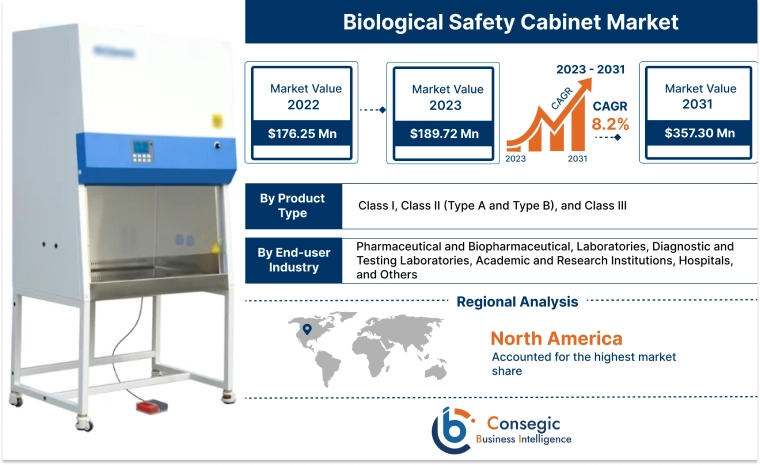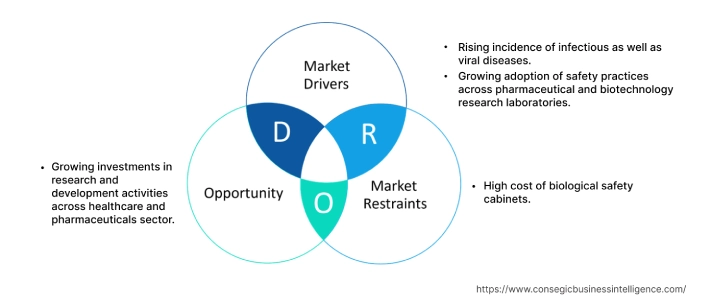- Summary
- Table Of Content
- Methodology
Biological Safety Cabinet Market Size :
Consegic Business Intelligence analyzes that the Global Biological Safety Cabinet Market size is growing with a CAGR of 8.2% during the forecast period (2023-2031). The market accounted for USD 176.25 million in 2022 and USD 189.72 million in 2023, and the market is projected to be valued at USD 357.30 Million by 2031.
Biological Safety Cabinet Market Scope & Overview:
Biological safety cabinets(BSCs) is an enclosed, ventilated laboratory workspace for safely working with materials contaminated with (or potentially contaminated with) pathogens requiring a defined biosafety level. They work by creating a negative pressure environment within the cabinet, which prevents hazardous materials from escaping into the surrounding environment. They also use HEPA filters to remove contaminants from the air inside the cabinet.
They are used in a variety of settings, including research laboratories, clinical laboratories, pharmaceutical manufacturing facilities, and food processing plants. They are essential for protecting laboratory workers and the environment from exposure to hazardous biological materials.
Biological Safety Cabinet Market Insights :
Key Drivers :
Rising incidence of infectious as well as viral diseases
The rising cases of lethal infectious diseases is one of the prominent reasons fuelling the demand for the safety cabinets which is driving the expansion of the market across the globe. The fright of spreading infection from person to person, person to animal, animal to person, or animal to animal is one of the predominant factors driving the rigorous growth in the production of the cabinets. Incidences caused by Covid-19 and the Ebola virus have boosted the use of the cabinets in the medical sector. Analysis of market trends concludes that the increasing prevalence of infectious and viral diseases across the globe is driving the usage of the cabinets across healthcare facilities. For instance, according to the report by the World Health Organization in March 2023, about half of the world's population is now at risk of dengue with an estimated 100–400 million infections occurring each year. Thus, the growing incidences of viral and infectious diseases across the globe is driving the biological safety cabinet market demand.
Growing adoption of safety practices across pharmaceutical and biotechnology research laboratories
Biological safety cabinets are essential equipment in the biotechnology and pharmaceutical industries. They provide a safe and controlled environment for working with hazardous biological materials, such as bacteria, viruses, and other pathogens. BSCs protect laboratory workers from exposure to these materials, and they also prevent the spread of contamination to the surrounding environment. There is a significant increase in the knowledge and awareness of safety precautions among the research professionals. This has increased the probability of utilizing the cabinets during harmful research and diagnostic procedures. Researchers implies the importance of using them while executing clinical procedures. For instance, in June 2020, Biopharma installed 10 Premium 212 Microbiology Safety Cabinets to a gene therapy company in White City, London.
Furthermore, vaccine production as well as the manufacturing of pharmaceutical drugs have mandatory requirements of the cabinets, and several professionals suggest it as a necessary precaution. For instance, according to a Survey conducted by Central for Disease Control & Prevention, 73% of laboratory staff prefer taking precautions while working in the lab environment. Analysis of market trends concludes that the increasing awareness of safety measures and preference to work in a safe set-up is expected to drive the growth of the market.
Key Restraints :
High cost of cabinets
Biological safety cabinets are complex pieces of equipment that require careful design and construction to ensure that they meet the highest safety standards. The their main purpose is to protect medical equipment/professionals/devices, products, and environment from hazardous pollutants during routine procedures They must be able to protect laboratory workers from exposure to hazardous biological materials, and they must also prevent the spread of contamination to the surrounding environment. It is very important to use quality materials while preparing the safety cabinets. Various materials like HEPA filters and UV germicidal lamps are expensive and they increase the overall cost of the cabinets. This results into less business initiatives taken by companies and start-ups. Analysis of market trends concludes that the high cost of the cabinet lowers the adoption of the equipment across small scale companies and thus hinders the growth of the market.
Future Opportunities :
Growing investments in research and development activities across healthcare and pharmaceuticals sector
The demand for more convenient solutions for biological safety cabinets has motivated the increase in investment in research and development activities. There is also an increase in funding and grants allotted to manufacturing companies by government and private institutions for innovative alternatives to existing safety cabinets. For instance, in September 2023, The Indian government approved an investment of USD 72.08 million to 74 industries in the pharmaceutical and medical device manufacturing sectors. The investment was approved under the production-linked incentive (PLI) scheme. Furthermore, government initiatives like ‘Make in India', ‘Atmanirbhar Bharat Abhiyan', and ‘Start up India' by the Indian government has motivated several budding businesses across the country to come up with advanced solutions to replace traditional safety cabinets. Analysis of market trends concludes that the consistent demand to come up with innovative alternatives is is emerging as one of many biological safety cabinet market opportunities that will drive market expansion.
Biological Safety Cabinet Market Report Insights :
| Report Attributes | Report Details |
| Study Timeline | 2017-2031 |
| Market Size in 2031 | USD 357.30 Million |
| CAGR (2023-2031) | 8.2% |
| By Product Type | Class I, Class II (Type A and Type B), and Class III |
| By End-user Industry | Pharmaceutical and Biopharmaceutical, Laboratories, Diagnostic and Testing Laboratories, Academic and Research Institutions, Hospitals, and Others |
| By Region | North America, Europe, Asia-Pacific, Latin America, and Middle East & Africa |
| Key Players | Thermo Fisher Scientific, Esco Micro, Labconco, The Baker Company, Kewaunnee Scientific, NuAire, GermFree Laboratories, Cruma, Air Science, BIOBASE, and Haier Biomedical |
Biological Safety Cabinet Market Segmental Analysis :
By Product Type :
The product type is categorized into class I, class II, and class III. The class II segment is further bifurcated into type A and type B. In 2022, the class II segment accounted for the highest market share of 47.63% in the biological safety cabinet market. The segment is popular because they offer a good balance of protection for laboratory workers and the environment, while also being relatively affordable and easy to use. Class II BSCs work by creating a negative pressure environment within the cabinet and using HEPA filters to remove contaminants from the air. The negative pressure environment prevents hazardous materials from escaping into the surrounding environment, and the HEPA filters remove contaminants from the air inside the cabinet. Examination of market trends concludes that the increasing launch of new Class II BSCs is driving the segment proliferation across the globe. For instance, in February 2021, Thermo Fisher Scientific launched the Thermo Scientific Herasafe 2025 for safe sample handling in life science applications. The product is part of Thermo Fisher Scientific's Class II BSC portfolio. Thus, the growing innovations in the product are driving the segment growth across the globe.
Moreover, the Class III segment is expected to hold the highest CAGR over the forecast period. The demand for Class III cabinets is increasing due to the rising concerns about the global spread of pandemics and viral diseases. For instance, in October 2023, the World Health Organization stated that from 12 to 15 September 2023, the Ministry of Health and Family Welfare, Government of India, reported six laboratories confirmed Nipah virus cases, including two deaths, in Kozhikode district, Kerala. Examination of market trends concludes that the growing prevalence of viral disease is expected to provide lucrative growth opportunity for segment proliferation across the globe.
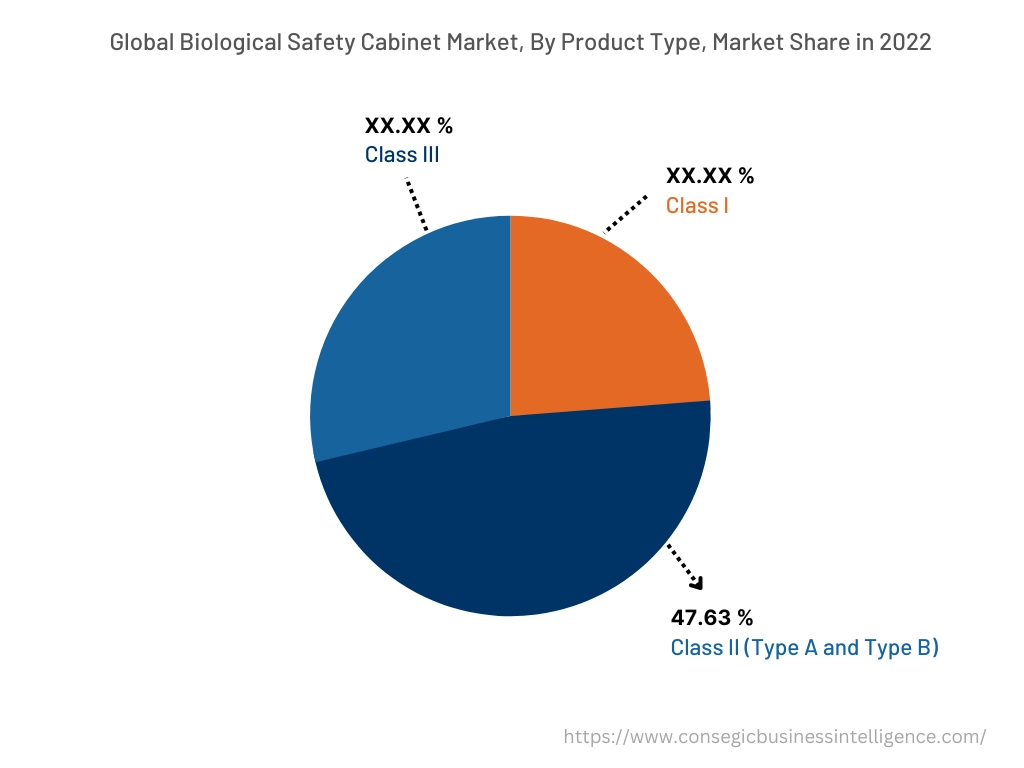
By End-Use-Industry :
The end-user industry segment is categorized into pharmaceutical and biopharmaceutical, laboratories, diagnostic and testing laboratories, academic and research institutions, hospitals, and others. In 2022, the pharmaceutical and biopharmaceutical segment accounted for the highest biological safety cabinet market share, and it is also expected to hold the highest CAGR over the forecast period. Analysis of market trends concludes that the growing investments in pharmaceutical and biotechnology research and development activities are driving the usage of BSCs from these industries. For instance, according to the 2021 European Union Industrial R&D Investment Scoreboard, health industries invested USD 199.24 billion in R&D in 2020, which accounted for 20.8% of total business R&D expenditure worldwide. Thus, the significant increase in research and development expenditure is driving the demand for the cabinets from the pharmaceutical and biopharmaceutical industries across the globe.
By Region :
The regional segment includes North America, Europe, Asia Pacific, the Middle East and Africa, and Latin America.
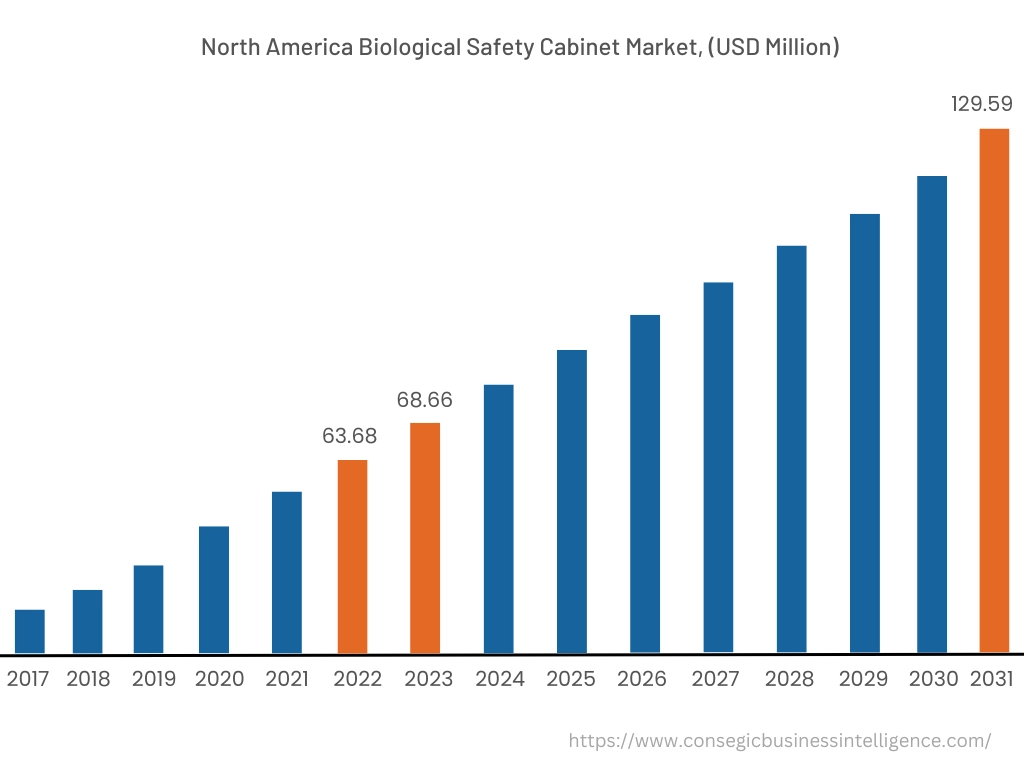
In 2022, North America accounted for the highest market share at 36.13% valued at USD 63.68 Million in 2022 and USD 68.66 Million in 2023, it is expected to reach USD 129.59 Million in 2031. In North America, the U.S. accounted for a major market share of 64.73% in the year 2022. Analysis of biological safety cabinet market trends concludes that the North America region growing owing to the significant increase in investments for pharmaceutical research and developments. The growing government investments in pharmaceutical research and development is driving the market across the region. For instance, according to the report by the National Center for Science and Engineering Statistics in September 2023, in financial year (FY) 2022, the 42 federally funded research and development centers (FFRDCs) in the United States spent USD 26.5 billion on research and development (R&D). This was a 6.4% increase from the previous year. Furthermore, according to the data published by the Congressional Budget Office in April 2021, The U.S. pharmaceutical industry spent $83 billion on R&D in 2019. This was more than 10 times the amount spent in the 1980s, adjusted for inflation. Thus, the growing pharmaceutical research and development spending across the region is driving biological safety cabinet market growth.
Furthermore, the Asia Pacific region is expected to witness significant growth over the forecast period, growing at a CAGR of 8.7% during 2023-2031. The biological safety cabinet market analysis concluded that significant development of the pharmaceutical and healthcare sector across the region is expected to increase the demand for biological safety cabinets across the region. For instance, according to the report by the Trade Promotion Council of India in August 2023, The Indian hospital industry has seen a significant increase in investments, particularly from private equity firms. In the last two years, it has transacted deals worth over USD 3.24 billion. All these above-mentioned factors are collectively driving the usage of biological safety cabinets from the pharmaceutical and healthcare sector in the Asia Pacific region and creating lucrative growth opportunities for the biological safety cabinet market in the Asia Pacific region.
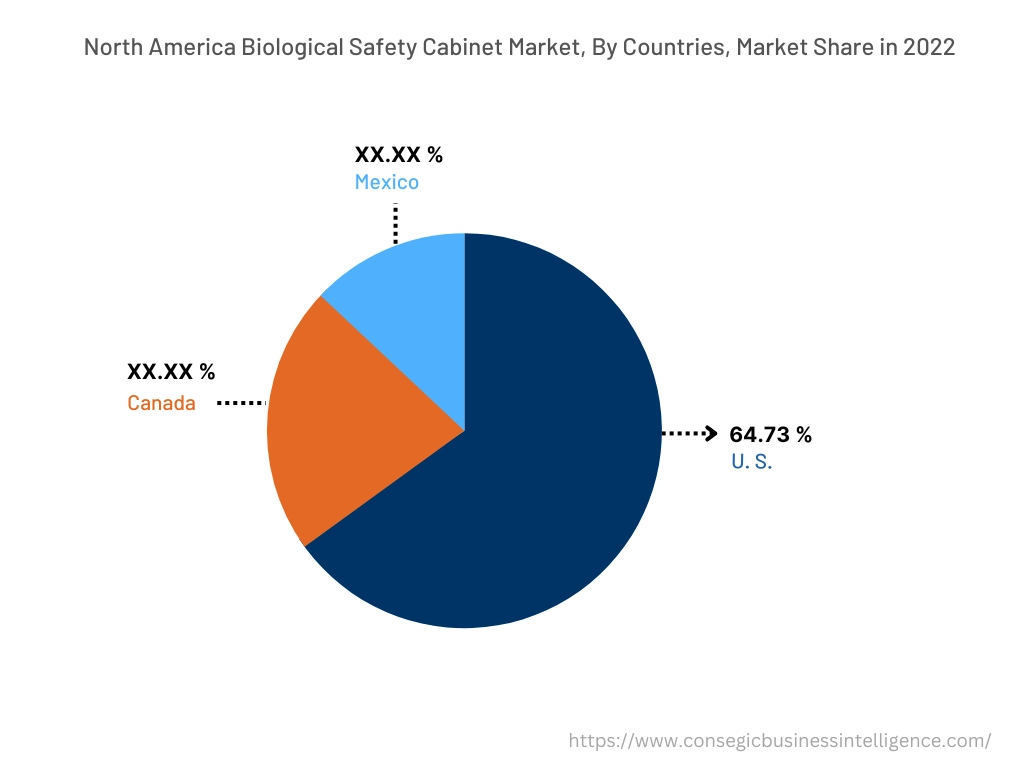
Top Key Players & Market Share Insights:
The biological safety cabinet market is highly competitive, with several large players and numerous small and medium-sized enterprises. The major companies operating in the biological safety cabinet industry have strong research and development capabilities and a strong presence in the market through their extensive product portfolios and distribution networks. The market is characterized by intense competition, with companies focusing on expanding their product offerings and increasing their market share through mergers, acquisitions, and partnerships. The key players in the market include-
- Thermo Fisher Scientific
- Esco Micro
- Cruma
- Air Science
- BIOBASE
- Haier Biomedical
- Labconco
- The Baker Company
- Kewaunnee Scientific
- NuAire
- GermFree Laboratories
Recent Industry Developments :
- In May 2021, Labconco launched updated Axiom biosafety cabinets with enhanced safety features. The Axiom cabinets are available in ISO ratings 5, 6, 7, and 8. They are ADA compliant and feature dual Type A2 and Type B2 modes. They are for Biosafety Level (BSL) 1, 2, and 3 containment or BSL 4 with PPE.
- In February 2021, Thermo Fisher Scientific expanded its Class II Biological Safety Cabinets. The cabinets are designed to protect users and samples in bioprocessing, clinical diagnostic, and biopharmaceutical laboratories.
Key Questions Answered in the Report
What was the market size of the biological safety cabinet market in 2022? +
In 2022, the market size of biological safety cabinet was USD 176.25 million.
What will be the potential market valuation for the biological safety cabinet industry by 2031? +
In 2031, the market size of biological safety cabinet will be expected to reach USD 357.30 million.
What are the key factors driving the growth of the biological safety cabinet market? +
Rising incidence of infectious as well as viral diseases across the globe is fueling market growth at the global level.
What is the dominant segment in the biological safety cabinet market for the product type? +
In 2022, the class II segment accounted for the highest market share of 47.63% in the overall Biological Safety Cabinet market.
Based on current market trends and future predictions, which geographical region is the dominating region in the Biological Safety Cabinet market? +
North America accounted for the highest market share in the overall market.
